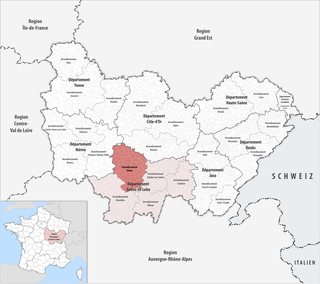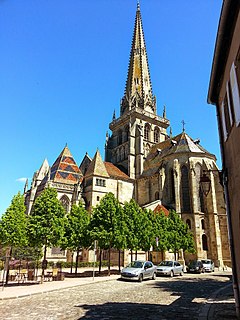See also
| This disambiguation page lists articles associated with the title Battle of Autun. If an internal link led you here, you may wish to change the link to point directly to the intended article. |
Battle of Autun may refer to:
| This disambiguation page lists articles associated with the title Battle of Autun. If an internal link led you here, you may wish to change the link to point directly to the intended article. |
Year 356 (CCCLVI) was a leap year starting on Monday of the Julian calendar. At the time, it was known as the Year of the Consulship of Constantius and Iulianus. The denomination 356 for this year has been used since the early medieval period, when the Anno Domini calendar era became the prevalent method in Europe for naming years.

Saône-et-Loire is a department in the Bourgogne-Franche-Comté region of central-eastern France. Named after the Saône and Loire between which it lies, it had a population of 555,023 in 2016. Its prefecture is Mâcon and subprefectures are Autun, Chalon-sur-Saône, Charolles and Louhans.

Magnus Magnentius was a usurper of the Roman Empire from 350 to 353.

Robert the Strong was the father of two kings of West Francia: Odo and Robert I of France. His family is named after him and called the Robertians. In 853, he was named missus dominicus by Charles the Bald, King of West Francia. Robert the Strong was the great-grandfather of Hugh Capet and thus the ancestor of all the Capetians.

Autun is a subprefecture of the Saône-et-Loire department in the Bourgogne-Franche-Comté region of central-eastern France. It was founded during the Principate era of the early Roman Empire by Emperor Augustus as Augustodunum to give a Roman capital to the Gallic people Aedui, who had Bibracte as their political centre. In Roman times the city may have been home to 30,000 to 100,000 people, according to different estimates. Nowadays, the commune has a population of about 15,000.

Richard, Duke of Burgundy (858–921), also known as Richard of Autun or Richard the Justiciar, was Count of Autun from 880 and the first Margrave and Duke of Burgundy. He eventually attained suzerainty over all the counties of Burgundy save Mâcon and by 890 he was referred to as dux (duke) and by 900 as marchio (margrave). By 918 he was being called dux Burgundionem or dux Burgundiae, which probably signified less the existence of a unified Burgundian dukedom than feudal suzerainty over a multiplicity of counties in a specific region.
The 5 arrondissements of the Saône-et-Loire department are:

The arrondissement of Autun is an arrondissement of France in the Saône-et-Loire department in the Bourgogne-Franche-Comté region. It has 89 communes. Its population is 131,392 (2016), and its area is 1,994.3 km2 (770.0 sq mi).
Bernard II was the Count of Barcelona, Girona and Margrave of Gothia and Septimania from 865 to 878.

The Roman Catholic Diocese of Autun (–Chalon-sur-Saône–Mâcon–Cluny), more simply known as the Diocese of Autun, is a diocese of the Latin Rite of the Roman Catholic Church in France. The diocese comprises the entire Department of Saone et Loire, in the Region of Bourgogne.

The Cathedral of Saint Lazarus of Autun, commonly known as Autun Cathedral, is a Roman Catholic cathedral in Autun and a national monument of France. Famous for its Cluniac inspiration and its Romanesque sculptures by Gislebertus it is a highlight in Romanesque art in Burgundy and it is the seat of the Bishop of Autun. The Bishop of Autun set forth the construction of St. Lazarus Cathedral as a result of the large movement of pilgrims travelling to Vezelay as they progressed on the pilgrimage route to Santiago de Compostela.
William of Septimania was the son of Bernard and Dhuoda. He was the count of Toulouse from 844 and count of Barcelona from 848.

Nicolas Rolin (1376–1462) was a leading figure in the history of Burgundy and France, becoming chancellor to Philip the Good.
Willibad, Willebad, or Willihad was the Patrician of Burgundy in the first half of the seventh century. Willibad may have been a Frank or perhaps a Burgundian, one of the last representatives of the native nobility which had been subdued by the Franks in 534. He died in the Battle of Autun in 642/643.

Saint-Méry is a commune in the Seine-et-Marne department in the Île-de-France region in north-central France.

The Madonna of Chancellor Rolin is an oil painting by the Early Netherlandish master Jan van Eyck, dating from around 1435. It is kept in the Musée du Louvre, Paris, and was commissioned by Nicolas Rolin, aged 60, chancellor of the Duchy of Burgundy, whose votive portrait takes up the left side of the picture, for his parish church, Notre-Dame-du-Chastel in Autun, where it remained until the church burnt down in 1793. After a period in Autun Cathedral, it was moved to the Louvre in 1805.

Cordesse is a commune in the Saône-et-Loire department in the region of Bourgogne in eastern France. It is located north of Autun.

Monthelon is a commune in the Saône-et-Loire department in the region of Bourgogne in eastern France. It is located just west of Autun.

Anvallus was a Gaulish god, known from several public inscriptions at Augustodunum (Autun). Two Latin inscriptions on altars were dedicated by gutuatres in requital of vows; both such dedications began with the formula Aug(usto) sacr(um). The title gutuater is typically understood to mean 'priest'; the gutuatres have at times been taken to be Romanized continuations of the druids. These altars were both discovered in 1900 on the site of Autun's railway station, along with a Greek-style helmet of thin bronze that would have been left there as a votive offering.
The battle of Autun was a pitched battle in 642 or 643, concluding a feud between Flaochad and Willebad, two magnates of the Merovingian kingdom of Burgundy. The battle is recounted in detail in the final chapter of the contemporary Chronicle of Fredegar and also in the biographies of saints Eligius of Noyon and Sigiramn. While Fredegar seems hostile to Willebad, the hagiographers are hostile to Flaochad. The anonymous author of Fredegar may have been an eyewitness.